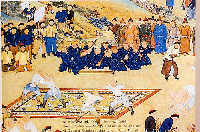 Blowing and percussion music is of similar importance as wind and drum music in north China such as shanxi, and has similar features and functions in South China.
Blowing and percussion music is of similar importance as wind and drum music in north China such as shanxi, and has similar features and functions in South China.
As the ancient poem lines go: "We worship our ancestors with music of qin, se and drum to pray for rain for the crops to stimulate our morale" Like drumbeat music, music of gong-and-drum has a long history and is colorful all over the country It is a popular folk art on the occasions such as festivals and celebrations and has taken deep root in local life. They are full of local flavors and cultural aesthetic meanings, among which, the most famous ones areJiangzhougong-and-drum music of Shanxi;shehuogong-and-drum music of Qinghai; Zhoushan gong-and-drum of Zhejiang;Daliuzi of Tujia ethnic group of Hunan;Chaozhoudaluogu of Guangdong. There are immeasurable cultural and art values in its music structure, colorful rhythms, moving expressive forms and deep music meanings.
As the ancient poem lines go: "Strings and Bamboos can make melodious music." Sizhu music or xiansuo music are popular practically all over the country, which is characterized by its special characters and lasting taste. In the north China, there are errentai paiziqu of Shanxi andInner Mongolia; xiansuo shisantao ofBeijing; pengbaban of Shandong; and bantouqu of Henan; in south China, the playing and enjoying of sizhu music such as Guangdong music, Jiangnan sizhu, Fujian nanyin has become a unique pastime.
 Court Music
Court Music
 There is a record about music in "Yugua in Tijing: "Emperors in ancient times eulogized virtues with music and made sacrifice to the God with magnificent music." Since the beginning of the Chinese nation, virtually all the dynasties have had the tradition that emperors eulogized virtues with music; therefore, court music is a national music with rich historical connotations. Since the establishment of the system of "music under government control" in the Northern Wei Dynasty, most of court musicians are from this system, which is especially obvious in the Ming andQing DynastyThat is to say, court is a place not only for the development and spreading of folk music, and court music is the flowering and polishing of folk music. As a result, Beijing Volume, Hebei Volume and Inner Mongolia Volume include some numbers of court music.
There is a record about music in "Yugua in Tijing: "Emperors in ancient times eulogized virtues with music and made sacrifice to the God with magnificent music." Since the beginning of the Chinese nation, virtually all the dynasties have had the tradition that emperors eulogized virtues with music; therefore, court music is a national music with rich historical connotations. Since the establishment of the system of "music under government control" in the Northern Wei Dynasty, most of court musicians are from this system, which is especially obvious in the Ming andQing DynastyThat is to say, court is a place not only for the development and spreading of folk music, and court music is the flowering and polishing of folk music. As a result, Beijing Volume, Hebei Volume and Inner Mongolia Volume include some numbers of court music.
